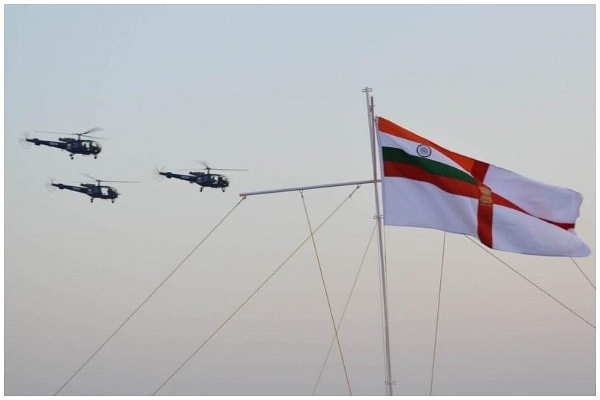
Helos For Navy: First Defence Buy Being Processed Under Strategic Partnership Model Gathers Pace
The government’s initiative to tie up with India’s private firms under the Strategic Partnership model is paving the way for urgent upgrade of the navy’s helicopter fleet.
The Indian Navy’s helicopter fleet is receiving a much-needed upgrade. In April, decks were cleared for the replacement of its fleet of obsolete Sea King anti-submarine helos with the US’ approval for the sale of 24 Lockheed Martin-Sikorsky MH-60R Romeos. And now, the process of replacement of the obsolete Chetak-Alouette III utility helicopters in service has gathered pace. Earlier this month, three foreign manufacturers — Airbus, Sikorsky and Kamov — submitted their technical bids to the Navy for its requirement of 111 naval utility helos.
The first two Aerospatiale Alouette IIIs arrived in India from France in mid-1964 packed in crates. Assembled by the navy's air engineers with French assistance at Cochin, these birds were embarked on the Vikrant aircraft carrier in July 1964. Since then, all the three services have used Alouette IIIs. The indigenised avatar of the helo, christened Chetak, was rolled out by the Hindustan Aeronautics Limited, then known as the Hindustan Aircraft Limited, in 1965.
With most of its backbone technology dating back to the 1950s, these helos are now obsolete. A number of Chetaks have been lost in accidents in the last few years, most recently in April 2019, when the crew had to ditch the aircraft in the Arabian Sea when it developed technical problems after taking off from a navy warship. And yet, around 40 Chetaks remain in service with the Indian Navy.
Navy’s Requirement
To replace these, the navy will have to choose from four options: Airbus Helicopters’ AS565 Panther and H135M, Lockheed Martin-Sikorsky S-76D and Kamov Ka-226T. Apart from being capable of carrying out logistics and search and rescue operations, the navy wants its new utility helos to be able to hunt submarines. In the Request for Information (RFI) put out in 2017, it said the helicopters need to be capable of sub-surface targeting. This effectively means that the helos should have the ‘ability to deploy torpedoes and depth charges’.
As Livefist points out, the RFI reveals that the navy wants the helo to be able to hover out of ground effect carrying two pilots and a lightweight torpedo, travel at least 30 nautical miles from its ship, launch its weapon and return to the ship with 20 minutes reserve of fuel.
"Will the Torpedo be capable of detecting, classifying and engaging submarines coated with anechoic materials, and transiting at less than 4 knots?” the navy has asked vendors in the RFI.
The need of having submarine hunting capabilities in utility helicopters appears to have been driven by the growing presence of the Chinese navy in the region. Multiple Chinese submarines, including a nuclear-armed one which docked in Colombo, have made forays into the Indian Ocean in the last few years.
The Indian Navy has been suffering from a shortage of submarine-hunting helos. The shortage is so acute that some of the warships go to sea without dedicated anti-submarine warfare (ASW) capability. Without enough ASW helos, Indian warships are virtually blind to and defenceless against enemy submarines.
In one such instance, the navy had to send four warships — INS Sahyadri and INS Satpura, guided-missile stealth frigates, INS Shakti, a fleet-tanker and support ship and INS Kirch, a guided-missile corvette — on a two-and-a-half-month long operational deployment to the PLAN dominated waters of South China Sea and the Pacific in 2016 with just one ASW-capable Sea King 42B and two Chetak utility helicopters.
Strategic Partnership Model
Approved in 2017, this is the first procurement that the government started pursuing under the Strategic Partnership (SP) model suggested by the Dhirendra Singh Committee and developed during late Manohar Parrikar’s tenure as Defence Minister. Under this model, the Defence Ministry will select Indian private firms to tie up with foreign original equipment manufacturer (OEM) to build weapon platforms in India under four segments — fighter aircraft, helicopter, submarine and armoured fighting vehicles or main battle tanks.
To ensure economic viability, and that more and more private firms get opportunities in defence manufacturing, the SP model envisages the selection of only one partner in each of the four categories.
“To ensure that larger number of companies participate in the process of defence manufacturing in the private sector, and the SP maintains focus on a core area of expertise, only one SP will generally be selected per segment. Addition of more segments or further subdivision of the identified segments may be considered by the MOD as deemed necessary,” the policy document reads.
In this case, the Defence Ministry has proposed that the first 16 helicopters of the total of 111 can be delivered from the OEM’s overseas production facility and the remaining will have to manufactured in India with the strategic partner.
The navy had issued the ‘request for expression of interest’ for the shortlisting of strategic partners in February. The government is likely to choose a strategic partner from amongst Tata Advanced Systems Limited, Mahindra Defence, Adani Defence, Larsen & Toubro, Kalyani Group and Reliance. Even though the model has been designed to promote private players in defence manufacturing, HAL and Indo-Russian Helicopters Limited— a joint venture set up by HAL, Russian Helicopters and Rosoboronexport, have also applied to be a strategic partner.
The next step would be the release of a request for proposal (RFP) by the navy for the shortlisted Indian companies, to which they will respond with a techno-commercial offer in collaboration with the OEMs, which will be shortlisted after the evaluation of their technical bids received this month. RFPs are likely to be issued to the Indian firms towards the end of the third quarter of this year.